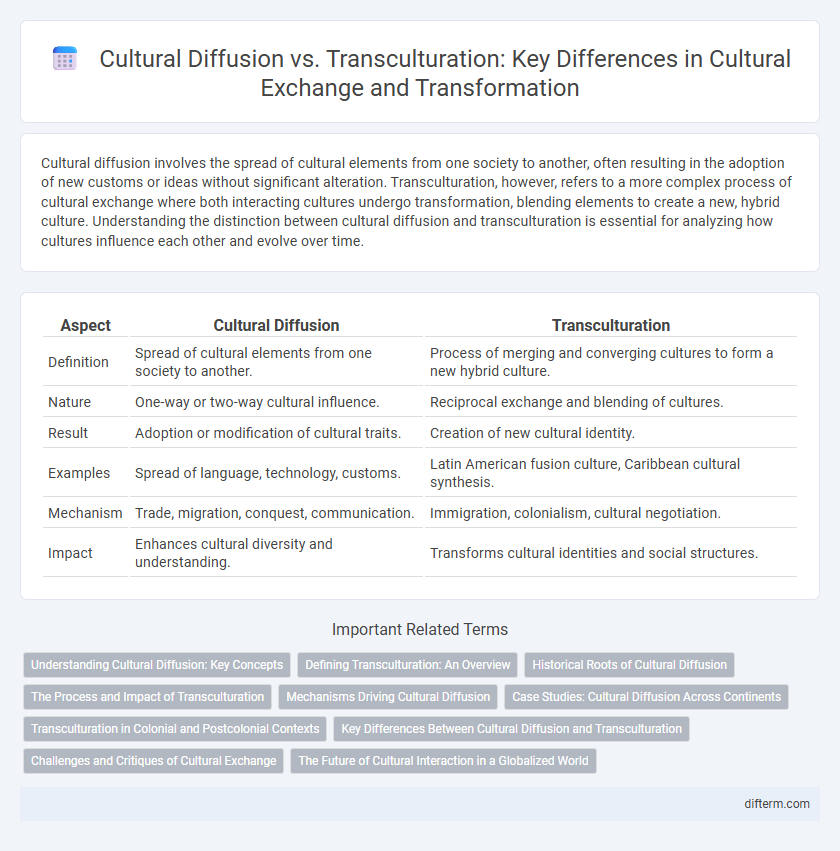Cultural diffusion involves the spread of cultural elements from one society to another, often resulting in the adoption of new customs or ideas without significant alteration. Transculturation, however, refers to a more complex process of cultural exchange where both interacting cultures undergo transformation, blending elements to create a new, hybrid culture. Understanding the distinction between cultural diffusion and transculturation is essential for analyzing how cultures influence each other and evolve over time.
Table of Comparison
| Aspect | Cultural Diffusion | Transculturation |
|---|---|---|
| Definition | Spread of cultural elements from one society to another. | Process of merging and converging cultures to form a new hybrid culture. |
| Nature | One-way or two-way cultural influence. | Reciprocal exchange and blending of cultures. |
| Result | Adoption or modification of cultural traits. | Creation of new cultural identity. |
| Examples | Spread of language, technology, customs. | Latin American fusion culture, Caribbean cultural synthesis. |
| Mechanism | Trade, migration, conquest, communication. | Immigration, colonialism, cultural negotiation. |
| Impact | Enhances cultural diversity and understanding. | Transforms cultural identities and social structures. |
Understanding Cultural Diffusion: Key Concepts
Cultural diffusion involves the spread of cultural elements such as ideas, practices, and technologies from one society to another, facilitating gradual integration and adaptation. It emphasizes the transmission and blending of cultural traits across geographical boundaries, often through trade, migration, or communication. Understanding cultural diffusion requires analyzing the mechanisms of cultural exchange and the resulting hybridization without significant loss of original cultural identities.
Defining Transculturation: An Overview
Transculturation refers to the process whereby individuals or groups undergo cultural transformation through the merging and converging of different cultural elements, resulting in the creation of new, hybrid cultural expressions. Unlike cultural diffusion, which involves the spread of cultural traits from one culture to another, transculturation emphasizes the reciprocal exchange and adaptation that modifies both originating and receiving cultures. This dynamic interaction highlights the complexity of cultural identity formation in multicultural societies.
Historical Roots of Cultural Diffusion
Cultural diffusion traces its historical roots to early human migrations and trade routes such as the Silk Road, where goods, ideas, and technologies spread across diverse societies. This process facilitated the exchange of cultural elements between distant civilizations, shaping social practices, languages, and religious beliefs over centuries. Unlike transculturation, which involves reciprocal cultural blending, cultural diffusion primarily denotes the unidirectional transmission of cultural traits.
The Process and Impact of Transculturation
Transculturation involves the dynamic and reciprocal exchange of cultural traits, resulting in the creation of new, hybrid cultural forms that reflect a blend of original influences. This process fosters deeper integration and mutual transformation between cultures, often impacting social identity, language, and customs in ways that surpass mere adoption or diffusion. The impact of transculturation can be seen in cultural innovations and increased intercultural understanding, promoting diversity while reshaping collective cultural narratives.
Mechanisms Driving Cultural Diffusion
Cultural diffusion operates through mechanisms such as trade, migration, and communication, facilitating the spread of ideas, customs, and technologies across societies. It often involves the gradual assimilation of cultural elements without significant alteration, allowing cultures to influence each other while maintaining distinct identities. This contrasts with transculturation, which entails a more complex exchange resulting in the creation of new, hybrid cultural forms.
Case Studies: Cultural Diffusion Across Continents
Cultural diffusion occurs when customs, ideas, and technologies spread from one culture to another, as seen in the Silk Road exchanges between Asia and Europe facilitating the transfer of silk, spices, and religious beliefs. Transculturation goes beyond diffusion by blending and transforming cultural elements into new forms, exemplified by the Afro-Caribbean identity emerging from African, Indigenous, and European interactions. Case studies of cultural diffusion across continents highlight the dynamic processes shaping global cultural landscapes through trade, migration, and colonization.
Transculturation in Colonial and Postcolonial Contexts
Transculturation in colonial and postcolonial contexts involves the complex exchange and transformation of cultural elements between colonizers and indigenous populations, leading to the creation of hybrid identities and new cultural expressions. Unlike cultural diffusion, which implies a one-way spread, transculturation emphasizes the reciprocal processes of assimilation, resistance, and adaptation that reshape languages, traditions, and social practices. This phenomenon is evident in Latin America, where indigenous, African, and European influences merge to form diverse cultural landscapes reflecting histories of conquest and survival.
Key Differences Between Cultural Diffusion and Transculturation
Cultural diffusion involves the spread of cultural elements such as traits, ideas, or technologies from one society to another, often resulting in the adoption or adaptation of these elements without significant changes to the original culture. Transculturation, however, describes a more complex process where two or more cultures merge, leading to the creation of new cultural expressions that combine features of the interacting cultures. Unlike cultural diffusion, transculturation emphasizes reciprocal exchange and transformation, highlighting the active and equal involvement of all cultures in shaping a shared cultural identity.
Challenges and Critiques of Cultural Exchange
Cultural diffusion often faces challenges such as cultural homogenization and loss of indigenous identities, sparking critiques about power imbalances where dominant cultures overshadow marginalized ones. Transculturation, while celebrated for its bidirectional cultural exchange, encounters difficulties in maintaining authenticity and addressing unequal cultural appropriation. Both processes invite scrutiny regarding ethical considerations and the complexities of preserving cultural diversity amid globalization.
The Future of Cultural Interaction in a Globalized World
Cultural diffusion facilitates the spread of ideas and practices across societies, fostering gradual assimilation and hybridization of cultural elements in a globalized world. Transculturation goes beyond diffusion by creating dynamic exchanges where cultures merge and transform, producing new, syncretic identities that challenge traditional boundaries. The future of cultural interaction will increasingly rely on transculturation processes to navigate multicultural complexities, emphasizing mutual influence and innovation over mere transmission.
Cultural Diffusion vs Transculturation Infographic

 difterm.com
difterm.com